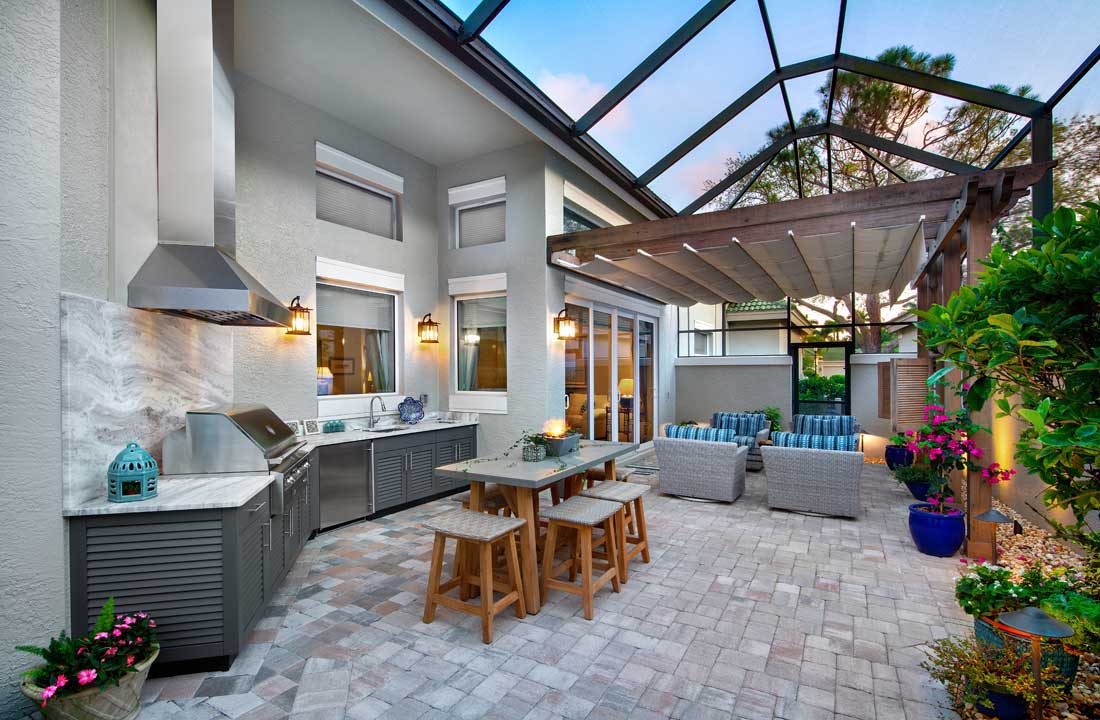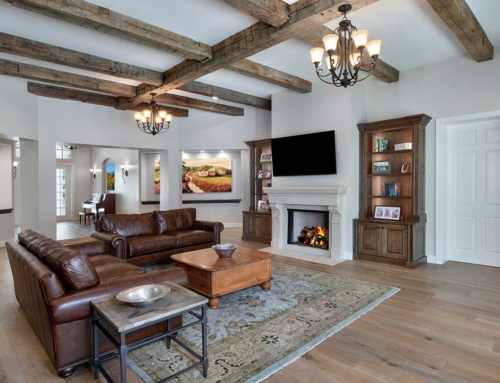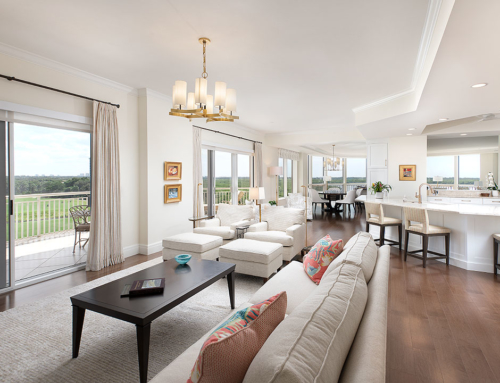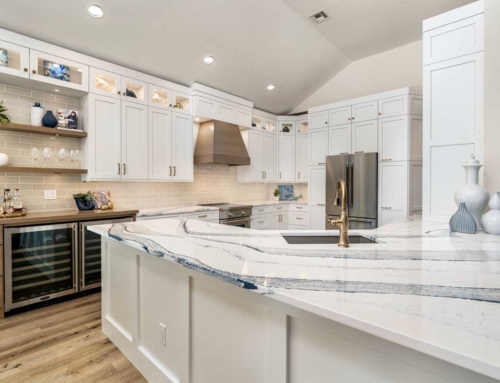A whole-house remodel is a significant undertaking, but with proper planning and care, it can also be an exciting one. Whether you want to finally realize your dream home, modernize outdated spaces, or boost property value ready for a sale, it’s essential to understand potential costs so you can plan accordingly. In this article, we guide you through current pricing, including what influences costs and how to budget wisely, so you can enjoy a successful home transformation without overspending.
2025 House Remodel Costs: National and Southwest Florida Averages
The cost to remodel an entire property can vary a lot depending on the scope of the remodel, the size of the home, and its location. Nationally, full remodels have an average cost ranging from roughly $18,000 at the low end to $600,000 and more at the high end.
Home size is a crucial factor. A house of 1,200 sq ft will range from the abovementioned $18,000 at the low-end (cosmetic renovations) to $72,000 at the mid-range (layout changes but not complete gutting), to $180,000 at the high-end (significant changes).
For a house size of 2,500 sq ft, this would amount to roughly $37,500 at the low end, $150,000 at the mid-range, and $375,000 at the high end.
For a larger home of 4,000 sq ft, you’d be looking at $60,000 at the low-end, $240,000 at the mid-range, and $600,000+ at the high-end.
Location also plays a key role in costs.
“Location matters. In coastal areas or upscale communities, local labor rates, permitting fees, and building code requirements can drive up costs significantly,” says David Wherry, President of Progressive Design Build. “Remodeling in Bonita Springs, for instance, is likely to cost more than in a rural inland town.”
Coastal areas, including those in Florida, generally have higher costs due to higher labor wages, increased demand, stricter building codes (especially in hurricane-prone regions), and often more expensive material transportation.
Costs are also significantly higher in densely populated urban centers, when compared to rural locations, due to increased demand for skilled labor, higher overhead for contractors, and more expensive permits and logistics.
Then there are the higher-cost areas and lower-cost regions. In New York City, the cost would be approximately $100 to $250 per square foot, whereas in the Midwest and South, it’d likely be lower.
Key Cost Drivers for Full Home Remodeling Projects
Several factors influence the cost of a whole-house remodel. Some are obvious, while others sometimes get overlooked.
Size of Your Home
The size of your home is one of the primary factors in determining the overall cost of a whole-house remodel. Larger homes require more materials, labor, and time, which naturally increases the total remodel costs. For example, a 4,000 sq ft home can cost significantly more than renovating a property half its size.
Materials
Material costs can make up 40-50% of your total renovation costs. Luxury home remodeling features such as custom cabinetry, imported tile, and stone countertops naturally cost more than builder-grade materials. What you choose will ultimately depend on your goals, budget, and the value that you want from your home renovation.
Project Scope
Your project scope plays a key role in determining remodeling costs. Simple cosmetic updates—such as painting or fixture replacements—are far more affordable than a gut renovation that involves tearing down walls, altering floor plans, or updating infrastructure. Structural changes and extensive redesigns require more planning, permits, and expert home remodeling contractors, which significantly impact the average cost.
Age and Condition of Your Home
The age and condition of your home play a significant part in your remodel costs. Older homes often need electrical, plumbing, or HVAC updates just to meet current codes. They may also require attention to issues such as mold, asbestos, and outdated layouts. Due to these existing problems, the majority of older home renovations can start at $100,000 and increase from there.
Permits
Securing proper permits is a must for most home remodeling projects, especially when altering the structure or square footage of your home. Projects such as room additions, the installation of new decks, or the construction of a garage typically require a building permit. Additionally, upgrades to mechanical, electrical, and plumbing (MEP) systems also fall under permit regulations. For larger renovations, permit costs can range from $500 to $2,500, depending on your location and the scope of the work. Be sure to factor these into your overall remodel cost to avoid delays and fines.
Average Remodeling Cost Per Square Foot in 2025
On average, whole-house remodeling costs in Southwest Florida range from $15 to $60 per square foot, with high-end renovations reaching $150–$300+ per square foot. These figures can vary widely based on your home’s existing condition, material selections, and the extent of structural or layout changes involved.
Here’s a breakdown to help set expectations:
Cosmetic Remodel
A cosmetic remodel focuses on surface-level improvements and typically ranges from $30 to $60 per square foot. These updates may include new paint, refreshed flooring, modern lighting, and minor repairs. While the layout and plumbing remain unchanged, these upgrades enhance aesthetics and add value—offering a cost-effective way to update a space without major disruption.
Mid-Range Remodel
With a mid-range home remodel, expect to invest between $60 and $150 per square foot. At this level, you’ll see more impactful changes, such as kitchen renovations, bathroom upgrades, layout reconfigurations, and moderate updates to electrical or plumbing systems. This option strikes a balance between cost and functionality, making it ideal for homeowners seeking meaningful improvements without committing to a full gut renovation.
High-End Remodel
A high-end remodel can completely transform your home, typically costing $150 to $300 per square foot or more. Full-scale renovations often involve moving walls, redesigning entire rooms, updating all mechanical systems, and incorporating premium finishes and custom craftsmanship. Also known as luxury home remodeling, this level of renovation transforms your home from the inside out—creating a fully customized, high-performance living space.
Before moving forward, it’s important to define your project goals and priorities. A trusted design-build partner can help you weigh your options and guide you toward smart investments for your property and lifestyle.
Budgeting Strategies and Hidden Renovation Costs
Setting a realistic budget for a full house remodel is vital. But it can be difficult without expert assistance. It’s easy to imagine that creating a solid budget is about listing materials and calculating labor. Yet good budgeting is also about anticipating the unexpected.
A smart starting point is to include a 10–20% contingency buffer. This safety net helps cover surprise expenses, such as unavoidable delays, structural issues, or mid-project design changes.
Beyond the obvious costs, several hidden expenses can catch homeowners off guard. Permit fees and inspections, for example, vary by municipality and can add thousands to your total. If you need to relocate temporarily, consider the cost of short-term housing or storage for your belongings.
“Design fees can catch people off guard. In traditional remodels, these are often separate from construction costs and can vary widely,” says David Wherry. “With design-build firms like Progressive, however, design fees are clearly outlined in a dedicated design agreement at the beginning of the process. This agreement covers planning, drawings, and material selections—providing clarity and precision before construction even begins.”
View Progressive’s Whole House Remodel portfolio
Renovation Cost Comparison: DIY vs. Contractor Services
When you see the price of a professional remodel, it can be tempting to take the DIY route—especially if you or a relative is handy. But any potential savings from DIY work often come with trade-offs in time, stress, and risk.
“You can cut labor costs by doing it yourself, but you also face making unintentional code violations and costly mistakes that require professional intervention at a later date,” adds David Wherry. “It can also be dangerous, with even a small error in structural work, electrical systems, or plumbing leading to an unsafe environment that will need to be fixed by experts.”
When you work with remodeling contractors from the beginning, such as a licensed design-build firm, they bring experience, streamlined coordination, and proper permit knowledge. While the upfront cost is higher, you gain project oversight, quality assurance, and peace of mind.
Design-build firms, such as Progressive Design Build, combine design and construction into a single process, reducing miscommunication and minimizing costly change orders. When you work with an experienced and dynamic team like ours, you’re investing in expert planning, clear timelines, and a smoother experience from start to finish.
While DIY projects may be suitable for minor cosmetic updates with minimal structural changes, a whole-house remodel typically benefits from professional execution, especially when long-term value is a priority.
How to Make Informed House Remodeling Decisions
It’s important to be knowledgeable of the key factors that influence pricing in a home remodel and the hidden expenses that can arise before embarking on a renovation project. This will ensure you’re better equipped to make informed decisions and avoid unpleasant surprises.
If you’re considering a remodel, now’s the time to gather estimates and speak with a qualified contractor who understands your vision.
Luxury Home Remodeling in Southwest Florida
Progressive is an award-winning design-build luxury remodeling firm founded in 1989 that serves Southwest Florida. Whether you’re looking to enhance an indoor or outdoor space – or create a new one – we’re the team that can get the job done.
Progressive Design Build is a trusted expert in custom home remodeling, from kitchens and bathrooms to whole houses, condos, and outdoor living projects. You can rely on our seamless processes, advanced technology, and exceptional customer service to deliver on-time and on-budget results.
Ready to talk about remodeling? Reach out directly to schedule a free consultation.
Not quite ready? Sign up for our monthly newsletter, view our portfolio, and follow us on Facebook and our other social media for brilliant design ideas and inspiration.
Frequently Asked Questions on Home Remodeling Costs
What Part of Home Renovations Adds the Most Value to a Home?
Kitchen remodeling adds the most value to a home, often recouping up to 80% of the remodel cost at resale. Other high-ROI home renovation projects include bathroom renovations, the addition of outdoor living spaces, and upgrades to systems like HVAC. Enhancements that improve accessibility (such as widened doorways or walk-in tubs) also increase value, especially for those aging in place or planning for retirement living.
How Much Should I Budget for a Whole-Home Remodel?
For a whole-house remodel, it’s wise to allocate about 30% of your home’s current market value as your remodeling budget. This ensures flexibility for custom home upgrades, material costs, and any required permits or unexpected work. Avoid spending more than 10–15% of your home’s value on a single room to maintain overall remodeling value and ROI.
Why Are Home Renovations and Remodeling Expensive?
Home remodeling projects often come with high costs due to the skilled labor, detailed planning, and coordination they require. Even simple renovations may involve wall removal, layout changes, or compliance with building codes. Costs also rise based on material selections, labor-intensive installations, and permitting requirements. Whether you’re undertaking a full gut renovation or a smaller upgrade, the level of customization and expertise directly impacts your total renovation cost.









